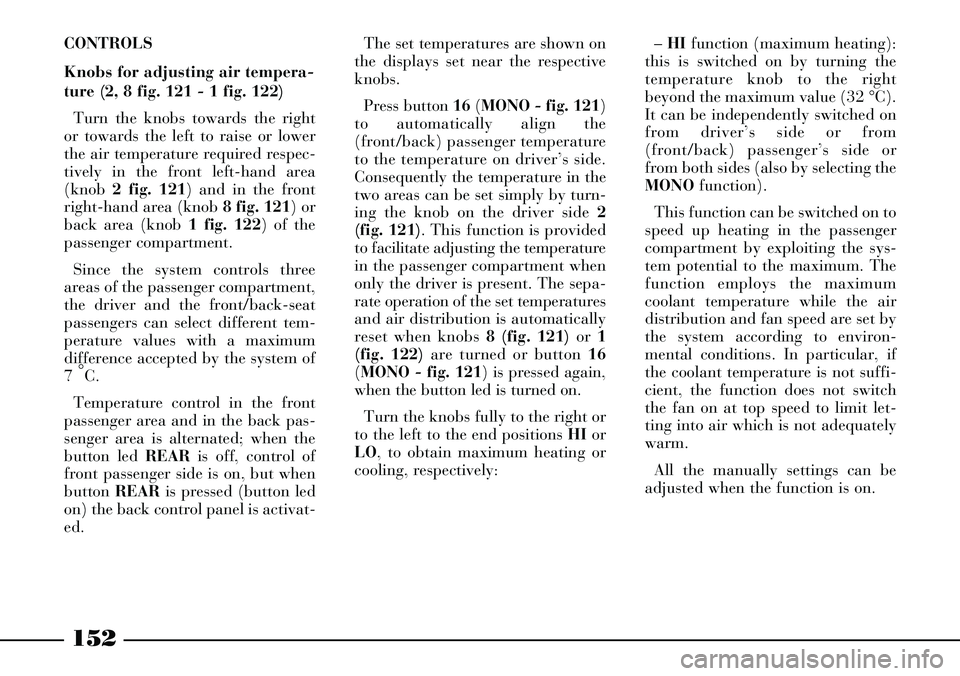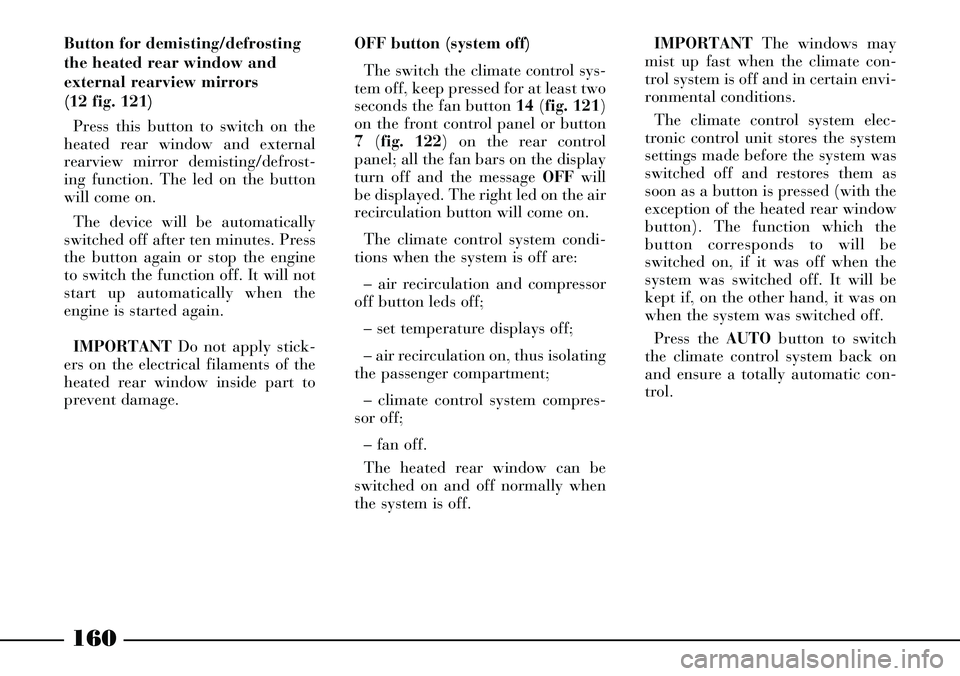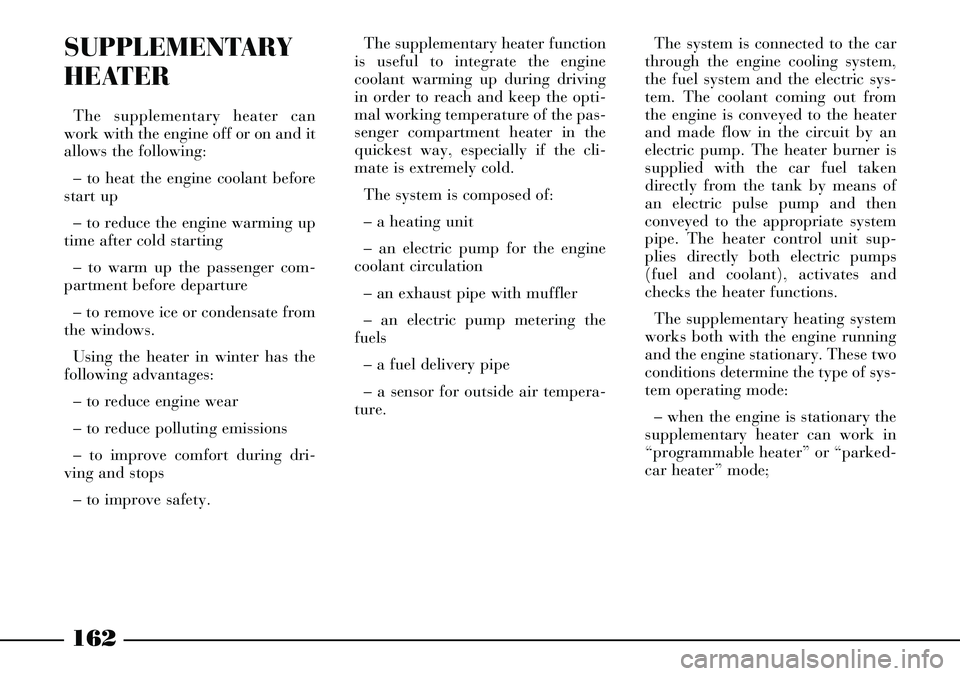ESP Lancia Thesis 2006 Owner handbook (in English)
[x] Cancel search | Manufacturer: LANCIA, Model Year: 2006, Model line: Thesis, Model: Lancia Thesis 2006Pages: 386, PDF Size: 8.69 MB
Page 129 of 386

128
ABS SYSTEM
Warning light/symbol
>
Message
SYSTEM
UNAVAILABLE
ABS SYSTEM FAULT
GO TO DEALER
ABS INDICATOR FAULT
GO TO DEALERMeaning of the message
System setting in progress
ABS system failure:
in this case the braking system
keeps its effectiveness,
but without the potential offered
by the ABS system. Drive with the
utmost care specially
in all cases of less than
perfect grip.
System is ok but the
warning light is failing and
cannot indicate the presence of
future failures of the ABS systemAction
–
Contact a Lancia Dealership
Contact a Lancia Dealership
ESP (ELECTRONIC STABILITY PROGRAM)
Warning light/symbol
á
Message
SYSTEM
UNAVAILABLE
ESP SYSTEM FAULT
GO TO DEALER
ESP INDICATOR FAULT
GO TO DEALERMeaning of the message
System setting in progress
ESP system failure
System is ok but the warning
light is failing and cannot indicate
the presence of future
failures/interventions of the ESP
systemAction
-
Contact a Lancia Dealership
Contact a Lancia Dealership
Page 149 of 386

148
FRONT CONTROL PANEL (fig. 121)
fig. 121L0A0054b
INITIALISING THE AIR
CONDITIONING CONTROL UNIT
Whenever the battery is electrically
connected again or it is reloaded
after being completely flat or after
replacing one of the protection fuses,
to restore the correct operation of
the air conditioning, of the door
locking and of the ESP system. It is
necessary to perform the initialisa-
tion operations contained in the
paragraph “If battery is to be dis-
connected” in the chapter “In an
emergency”.
Page 153 of 386

152
CONTROLS
Knobs for adjusting air tempera-
ture (2, 8 fig. 121 - 1 fig. 122)
Turn the knobs towards the right
or towards the left to raise or lower
the air temperature required respec-
tively in the front left-hand area
(knob 2 fig. 121) and in the front
right-hand area (knob 8 fig. 121) or
back area (knob 1 fig. 122) of the
passenger compartment.
Since the system controls three
areas of the passenger compartment,
the driver and the front/back-seat
passengers can select different tem-
perature values with a maximum
difference accepted by the system of
7 °
C.
Temperature control in the front
passenger area and in the back pas-
senger area is alternated; when the
button led REARis off, control of
front passenger side is on, but when
button REARis pressed (button led
on) the back control panel is activat-
ed. The set temperatures are shown on
the displays set near the respective
knobs.
Press button 16(MONO - fig. 121)
to automatically align the
(front/back) passenger temperature
to the temperature on driver’s side.
Consequently the temperature in the
two areas can be set simply by turn-
ing the knob on the driver side 2
(fig. 121). This function is provided
to facilitate adjusting the temperature
in the passenger compartment when
only the driver is present. The sepa-
rate operation of the set temperatures
and air distribution is automatically
reset when knobs 8 (fig. 121) or 1
(fig. 122) are turned or button 16
(MONO - fig. 121) is pressed again,
when the button led is turned on.
Turn the knobs fully to the right or
to the left to the end positions HIor
LO, to obtain maximum heating or
cooling, respectively:– HIfunction (maximum heating):
this is switched on by turning the
temperature knob to the right
beyond the maximum value (32 °C).
It can be independently switched on
from driver’s side or from
(front/back) passenger’s side or
from both sides (also by selecting the
MONOfunction).
This function can be switched on to
speed up heating in the passenger
compartment by exploiting the sys-
tem potential to the maximum. The
function employs the maximum
coolant temperature while the air
distribution and fan speed are set by
the system according to environ-
mental conditions. In particular, if
the coolant temperature is not suffi-
cient, the function does not switch
the fan on at top speed to limit let-
ting into air which is not adequately
warm.
All the manually settings can be
adjusted when the function is on.
Page 155 of 386

154
When a combined function is set, if
a button is pressed the main func-
tion of the button pressed is activat-
ed, together with those already set. If
the button corresponding to a func-
tion which is already on is pressed,
such function will be cancelled (the
related led turns off).
Press the AUTObutton to restore
air distribution control after a man-
ual setting.
When the driver selects the air dis-
tribution to the windscreen, also the
passenger side air flow is automati-
cally directed to the windscreen.
Anyway, the passenger can select
another air distribution pattern, by
pressing the related buttons.Buttons for adjusting rear air
distribution (6, 9 fig. 122)
When the back control panel is
activated, it is possible to set one of
the three air distribution patterns for
the passenger compartment back
area by pressing the related buttons:
DAir flow to back central vents.
SAir flow to rear footwells. This air
distribution pattern, due to the nat-
ural tendency of heat to move
upwards, offers a prompt feeling of
warmth to the coolest parts of the
body.
SD
Air flow shared between rear
footwell vents (warmer air) and cen-
tral rear vents (cooler air).
Air distribution setting is displayed
when leds relevant to the selected
button are lit, which will be turned
off in case of fully automatic opera-
tion (FULL AUTO). When a combined function is set, if
a button is pressed the main func-
tion of the button pressed is activat-
ed, together with those already set. If
the button corresponding to a func-
tion which is already on is pressed,
such function will be cancelled (the
related led turns off).
Press the AUTObutton to restore
air distribution control after a man-
ual setting.
Page 156 of 386

155
Buttons for adjusting fan speed
(13, 14 fig. 121 – 7, 8 fig. 122)
Press respectively front control
buttons 13or 14 (fig. 121) and back
control buttons 8or 7 (fig. 122) to
increase or decrease the fan speed so
to adjust the amount of air let into
the passenger compartment while
keeping the required temperature
constant.
The fan speed is indicated by the
bars which light up on the front dis-
play 5 (fig. 121) and rear display 3
(fig. 122), when the back control
panel is active. Repeatedly press
button or keep pressed 13 (fig. 121)
or 8(fig. 122) to switch the fan on
at top speed (all bars on).
Repeatedly press or keep pressed
button 14(fig. 121) or 7(fig. 122)
to switch the fan on at minimum
speed (one bar on).When the fan minimum speed is
set up (one bar on), by keeping
pressed for at least two seconds but-
ton 14(fig. 121) or 7(fig. 122), the
climate control system is deactivated
and all the fan bars on the display
turn off; OFFmessage is displayed.
The fan speed can be adjusted
manually through both the front
control panel and the rear control
panel, but it is the same one for the
whole passenger compartment.
IMPORTANTPress the AUTO
button to restore air distribution
control after a manual setting.AUTO buttons
(automatic operation)
(1, 9 fig. 121 - 5 fig. 122)
Press the AUTObutton on the dri-
ver side and/or front/back-seat pas-
senger side: the system will automat-
ically control the air amount and
distribution pattern in the related
passenger compartment areas and
will cancel all the previously made
settings. This condition is marked by
the message FULL AUTOon the
system front and rear display,
besides the leds on the air distribu-
tion buttons turning off.
If one of the functions automatical-
ly controlled by the system (air recir-
culation, air distribution, fan speed
or air conditioner compressor deacti-
vation) is manually adjusted, the
message FULLon the display turns
off to indicate that the system is no
longer controlling the functions inde-
pendently (apart from temperature
control that is always automatic).
Page 159 of 386

158
IMPORTANTAir at a temperature
lower than that of the outside air
cannot be let in to the passenger
compartment when the compressor
is off. Furthermore, in particular
environmental conditions, the win-
dows could mist up fast because the
air is no longer dehumidified.
The setting will be stored when the
engine is stopped. Either press √
button again or press the AUTObut-
ton to reset automatic control of the
compressor (in the latter case, the
manual settings will be cancelled).
The led on the √button will go out. IMPORTANTThe air recircula-
tion function will allow, according to
the system operation (i.e. heating or
cooling) to reach the required condi-
tions faster. We recommend not
turning on this function on rainy
and/or cold days as this will consid-
erably increase window misting,
especially if the climate control sys-
tem is off.
In particular climate
conditions (e.g. low out-
side temperature or high
humidity) and with the inside air
recirculation automatic control
on, windows could start misting
up. In this case, press the air
recirculation button and set it to
forced open position (both button
leds off), and increase air flow to
the windscreen, if required.Climate control system
compressor off button (7 fig. 121)
Press the √button, when the but-
ton led is on, to switch the air condi-
tioner compressor off. The led will
go off. By pressing again the button
when the led is off, the system auto-
matic control of the compressor acti-
vation is restored; this situation is
indicated by button led lighting up.
When the air conditioner compres-
sor is off, if the system is no longer
able to keep the requested tempera-
ture, the message FULL AUTOon
the display turns off and the system
deactivates air recirculation to pre-
vent window misting up. Instead, if
the system is still able to maintain
the requested temperature, the mes-
sage FULLon the display will stay
on.
Page 161 of 386

160
Button for demisting/defrosting
the heated rear window and
external rearview mirrors
(12 fig. 121)
Press this button to switch on the
heated rear window and external
rearview mirror demisting/defrost-
ing function. The led on the button
will come on.
The device will be automatically
switched off after ten minutes. Press
the button again or stop the engine
to switch the function off. It will not
start up automatically when the
engine is started again.
IMPORTANTDo not apply stick-
ers on the electrical filaments of the
heated rear window inside part to
prevent damage.OFF button (system off)
The switch the climate control sys-
tem off, keep pressed for at least two
seconds the fan button 14 (fig. 121)
on the front control panel or button
7 (fig. 122) on the rear control
panel; all the fan bars on the display
turn off and the message OFFwill
be displayed. The right led on the air
recirculation button will come on.
The climate control system condi-
tions when the system is off are:
– air recirculation and compressor
off button leds off;
– set temperature displays off;
– air recirculation on, thus isolating
the passenger compartment;
– climate control system compres-
sor off;
– fan off.
The heated rear window can be
switched on and off normally when
the system is off.IMPORTANTThe windows may
mist up fast when the climate con-
trol system is off and in certain envi-
ronmental conditions.
The climate control system elec-
tronic control unit stores the system
settings made before the system was
switched off and restores them as
soon as a button is pressed (with the
exception of the heated rear window
button). The function which the
button corresponds to will be
switched on, if it was off when the
system was switched off. It will be
kept if, on the other hand, it was on
when the system was switched off.
Press the AUTObutton to switch
the climate control system back on
and ensure a totally automatic con-
trol.
Page 162 of 386

161
ACTIVE CARBON
DUST/POLLEN FILTER
The filter has the specific capacity
of combining a mechanical air
cleaning action and an electrostatic
effect so that the air let into the pas-
senger compartment is purified from
particles such as dust, pollen, etc.
In addition to this function, the fil-
ter efficaciously reduces the concen-
tration of pollutants thanks to a
layer of active carbon inside the fil-
ter.
The filtering action is carried out
on the air let in from outside (recir-
culation off).
Have the filter checked at least
once a year at a Lancia
Dealership, ideally at the begin-
ning of the summer.The efficacy of the cli-
mate control system may
be considerably reduced
if the filter is not replaced.Fan actuation is automatic and air
distribution corresponds to the latest
setting made before switching the
car off.
This function is useful especially on
summer days since it greatly reduces
the temperature inside the passenger
compartment as well as the duration
of the cooling cycle after car start-
up, thus avoiding the accumulation
of warm air in the air conditioning
unit lines.
IMPORTANTBest operation of
the fan when the car is parked is
obtained by closing completely the
windows and sunroof. Furthermore,
to check operation at first speed of
the fan, disengage air vents and set
air distribution from central dash-
board vents only before leaving the
car.You should have the filter checked
and if required replaced more fre-
quently if the car is mainly used in
polluted or dusty areas.
VENTILATION DURING A STOP
In versions with sunroof, the roof
top features 21 photovoltaic cells
supplying a maximum power of 24
W to supply the climate control sys-
tem fan when the car is parked with
the roof closed or horizontally pivot-
ing.
Page 163 of 386

162
SUPPLEMENTARY
HEATER
The supplementary heater can
work with the engine off or on and it
allows the following:
– to heat the engine coolant before
start up
– to reduce the engine warming up
time after cold starting
– to warm up the passenger com-
partment before departure
– to remove ice or condensate from
the windows.
Using the heater in winter has the
following advantages:
– to reduce engine wear
– to reduce polluting emissions
– to improve comfort during dri-
ving and stops
– to improve safety.The supplementary heater function
is useful to integrate the engine
coolant warming up during driving
in order to reach and keep the opti-
mal working temperature of the pas-
senger compartment heater in the
quickest way, especially if the cli-
mate is extremely cold.
The system is composed of:
– a heating unit
– an electric pump for the engine
coolant circulation
– an exhaust pipe with muffler
– an electric pump metering the
fuels
– a fuel delivery pipe
– a sensor for outside air tempera-
ture.The system is connected to the car
through the engine cooling system,
the fuel system and the electric sys-
tem. The coolant coming out from
the engine is conveyed to the heater
and made flow in the circuit by an
electric pump. The heater burner is
supplied with the car fuel taken
directly from the tank by means of
an electric pulse pump and then
conveyed to the appropriate system
pipe. The heater control unit sup-
plies directly both electric pumps
(fuel and coolant), activates and
checks the heater functions.
The supplementary heating system
works both with the engine running
and the engine stationary. These two
conditions determine the type of sys-
tem operating mode:
– when the engine is stationary the
supplementary heater can work in
“programmable heater” or “parked-
car heater” mode;
Page 175 of 386

174
Lift cover Aset at the driver's left
and press button Bto reset the fuel
cut-off switch.
Resetting the circuit breaker
Before resetting the cir-
cuit breaker, carefully
check for any fuel leaks or
damages to the car electric devices
(e.g.: headlights).Circuit breaker is located on the left
side of the boot, inside a box directly
set and connected to the battery pos-
itive terminal.
To reach the circuit breaker:
1) Open the tailgate.
2) Loosen knob A(fig. 130) and re-
move the battery cover B.
3) Press tabs A(fig. 131) and re-
move cover B.
4) Press button A(fig. 132) to reset
the circuit breaker.Initialising the control units of
the door locks, air conditioner
and ESP system
After resetting the circuit breaker, to
restore correct door locking, air con-
ditioning and ESP system, perform
the following operations:
1) Close the doors and the tailgate,
fit the key into the lock of one of the
front doors and perform a door cen-
tralised opening/closing cycle.
2) Start the engine and turn on the
compressor of the conditioner, setting
a lower temperature value than that
of the environment and check
whether the led on the disconnection
push button of the conditioner com-
pressor òis lit.
3) Turn the steering wheel one
fourth turn at least (the car can be at
standstill but the engine shall be run-
ning) and start running the car for a
few metres in a straight line until the
ESP warning light
áis off.
fig. 131
L0A0031b
fig. 132
L0A0347b